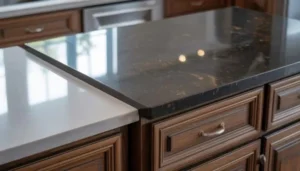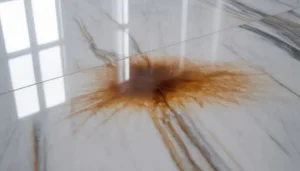How to Clean Travertine Tile Shower: Mastering the Art of Bathroom Elegance
When it comes to maintaining the beauty of your bathroom’s travertine shower, SF Marble And Granite Inc stands as your trusted partner. Their specialized range of products is tailored to enhance and preserve your travertine’s natural elegance. By integrating SF Marble And Granite Inc into your routine, you’ll discover the secret to a pristine travertine tile shower. Travertine tile showers add a touch of luxury to any bathroom, but to keep them looking their best, regular maintenance and proper cleaning are essential. In this guide, we’ll walk you through the process of cleaning and maintaining your travertine tile shower. From choosing the right cleaning products to removing stubborn stains, we’ve got you covered.
Table of Contents
ToggleUnderstanding Travertine Tile

Travertine is a type of natural stone known for its distinctive patterns and earthy colors. When used in showers, it can create a stunning and timeless appearance. However, it’s important to understand that travertine is porous, which means it has tiny holes and spaces within the stone.
The porosity of travertine is both a unique feature and a potential challenge. While it gives the stone its character, it also makes travertine more susceptible to staining and damage compared to non-porous materials.
To maintain the beauty and longevity of your travertine tile shower, it’s crucial to know how to clean and care for it properly. This includes regular cleaning routines, the use of appropriate cleaning products, and taking precautions to prevent stains and moisture-related issues.
Preparation
Before you begin the process of cleaning and maintaining your travertine tile shower, it’s essential to make proper preparations. This ensures that you have everything you need and that you protect the surrounding areas from potential damage.
Gather Your Cleaning Supplies
Get the following cleaners before you begin:
- Soft-Bristle Brush: You’ll need a soft-bristle brush to gently scrub the travertine tiles without scratching or causing any damage.
- pH-Neutral Cleaner: Choose a pH-neutral cleaner specifically designed for natural stone surfaces. Avoid acidic or abrasive cleaners, as they can harm travertine.
- Distilled Water: Using distilled water is preferable to tap water, as it doesn’t contain minerals that can leave residue on your tiles.
- Microfiber Cloth: A microfiber cloth is excellent for wiping and drying the surfaces after cleaning. It’s soft and won’t scratch the tiles.
Protecting the Surrounding Areas
While cleaning your travertine tile shower, take precautions to protect any adjacent or surrounding surfaces:
- Cover Faucets and Fixtures: Use plastic bags or towels to cover faucets, showerheads, and any metal fixtures to prevent accidental splashes of cleaning solution.
- Tape Off Grout Lines: Delicate grout lines can be sensitive to cleaning agents. You can use painter’s tape to cover the grout lines if you’re concerned about the cleaner affecting them.
Regular Cleaning
To ensure that your travertine tile shower retains its pristine appearance, it’s essential to establish a regular cleaning routine. Regular maintenance not only keeps your shower looking beautiful but also prevents the buildup of grime and stains. Below, we outline the steps for both daily and weekly cleaning to help you maintain your travertine shower effectively.
Daily Maintenance
Wipe Down Surfaces: After each shower, use a soft, damp cloth or a squeegee to wipe down the travertine tile surfaces. This removes soap scum, water spots, and excess moisture. Pay special attention to the areas where water accumulates, such as the corners and lower tiles.
Dry Thoroughly: Ensure that the shower enclosure is well-ventilated to allow for quick drying. Use a microfiber cloth to dry any remaining moisture, especially on the tiles and glass doors. Mineral buildup and water stains are reduced as a result.
Weekly Cleaning Routine
In addition to daily maintenance, it’s essential to perform a more thorough cleaning of your travertine tile shower once a week. Follow these steps:
Prepare Your Cleaning Solution: Mix a small amount of pH-neutral cleaner with distilled water. Avoid using abrasive or acidic cleaners, as they can damage the travertine surface.
Apply the Cleaning Solution: Using a soft-bristle brush or a sponge, apply the cleaning solution to the tiles. Start from the top and work your way down to prevent streaks and drips.
Gently Scrub: With a gentle touch, scrub the tiles, focusing on areas with soap scum or visible dirt. Avoid using excessive pressure, as travertine is a delicate stone.
Rinse Thoroughly: Use clean, distilled water to rinse away the cleaning solution. Ensure there are no residues left on the tiles.
Dry the Surfaces: Once you’ve rinsed thoroughly, use a microfiber cloth to dry the shower surfaces. This step prevents water spots and leaves your tiles gleaming.
Cleaning Products for Travertine Tiles: Natural vs. Chemical Cleaners
Choosing the right cleaning products is a crucial step in maintaining your travertine tile shower’s beauty and longevity. When it comes to cleaning solutions, you’ll encounter two main categories: natural cleaners and chemical cleaners. Let’s explore the differences and considerations for each.
Natural Cleaners
Advantages of Natural Cleaners:
- Gentle on Stone: Natural cleaners are typically milder and gentler on travertine tiles. They won’t strip away the stone’s natural finish or cause etching.
- Environmentally Friendly: Many natural cleaners are eco-friendly and biodegradable, making them a responsible choice for the environment.
- Non-Toxic: They are often non-toxic and safe for household use, reducing health risks for you and your family.
Examples of Natural Cleaners:
- Vinegar and Water: A mixture of white vinegar and distilled water is an effective natural cleaner for travertine tiles. It helps remove mineral deposits and soap scum.
- Castile Soap: Diluted castile soap can be used to clean travertine surfaces gently. It’s free from harsh chemicals.
Chemical Cleaners
Advantages of Chemical Cleaners:
- Effective Against Tough Stains: Chemical cleaners may be more effective at removing stubborn stains, such as mold or mildew.
- Convenience: Some chemical cleaners come in spray bottles, making them convenient for quick clean-ups.
Considerations for Chemical Cleaners:
- Acidity: Chemical cleaners can be acidic, and some may contain harsh chemicals that can damage travertine tiles if not used carefully. Always read the product label and follow instructions.
- Ventilation: When using chemical cleaners, ensure proper ventilation to minimize exposure to fumes.
Recommended Brands:
If you opt for chemical cleaners, choose those specifically designed for natural stone surfaces and follow these guidelines:
- Look for products with a pH level close to neutral (around 7) to minimize the risk of etching.
- Avoid cleaners containing ammonia, bleach, or abrasive particles.
- Test the cleaner in an inconspicuous area of your travertine tiles before using it on the entire surface.
Removing Stains from Travertine Shower
Stains on your travertine tile shower can be frustrating, but with the right knowledge and techniques, you can effectively address them. In this section, we’ll first discuss how to identify common stains that can affect your travertine shower, and then we’ll explore stain removal techniques.
Identifying Common Stains
- Hard Water Stains: Hard water contains minerals like calcium and magnesium, which can leave behind white or cloudy deposits on your tiles and glass. These stains often appear as water spots and can accumulate over time.
- Soap Scum: Soap scum is a mixture of soap residue, minerals, and water. It can create a hazy or milky film on the tile surfaces, especially in areas frequently exposed to soap and water.
- Mold and Mildew: In humid environments, such as bathrooms, mold and mildew can develop on the grout lines and in corners. They typically appear as black or greenish spots and can be accompanied by a musty odor.
- Rust Stains: Rust stains may occur if metal objects, like shaving razors or cans, come into contact with your travertine shower surfaces. These stains often manifest as reddish-brown discolorations.
Stain Removal Techniques
For Hard Water Stains:
- Vinegar solution: Combine equal volumes of water and white vinegar. After applying the solution to the spots, wait a few minutes before removing it. Gently scrub with a soft brush or sponge. Rinse thoroughly.
- Commercial Hard Water Stain Removers: Some specialized hard water stain removers are available. Follow the product instructions carefully.
For Soap Scum:
- Baking Soda and Water: Create a paste by mixing baking soda with water. Apply it to the soap scum, let it sit for a while, and then scrub gently. Rinse thoroughly.
- Vinegar and Dish Soap: Combine white vinegar and a few drops of dish soap in a spray bottle. Spray the mixture on the soap scum, let it sit, and then scrub away the residue.
Stains on your travertine tile shower can be frustrating, but with the right knowledge and techniques, you can effectively address them. In this section, we’ll first discuss how to identify common stains that can affect your travertine shower, and then we’ll explore stain removal techniques.
Identifying Common Stains
- Hard Water Stains: Hard water contains minerals like calcium and magnesium, which can leave behind white or cloudy deposits on your tiles and glass. These stains often appear as water spots and can accumulate over time.
- Soap Scum: Soap scum is a mixture of soap residue, minerals, and water. It can create a hazy or milky film on the tile surfaces, especially in areas frequently exposed to soap and water.
- Mold and Mildew: In humid environments, such as bathrooms, mold and mildew can develop on the grout lines and in corners. They typically appear as black or greenish spots and can be accompanied by a musty odor.
- Rust Stains: Rust stains may occur if metal objects, like shaving razors or cans, come into contact with your travertine shower surfaces. These stains often manifest as reddish-brown discolorations.
Stain Removal Techniques
For Hard Water Stains:
- Vinegar solution: Combine equal volumes of water and white vinegar. After applying the solution to the spots, wait a few minutes before removing it. Gently scrub with a soft brush or sponge. Rinse thoroughly.
- Commercial Hard Water Stain Removers: Some specialized hard water stain removers are available. Follow the product instructions carefully.
For Soap Scum:
- Baking Soda and Water: Create a paste by mixing baking soda with water. Apply it to the soap scum, let it sit for a while, and then scrub gently. Rinse thoroughly.
- Vinegar and Dish Soap: Combine white vinegar and a few drops of dish soap in a spray bottle. Spray the mixture on the soap scum, let it sit, and then scrub away the residue.
For Mold and Mildew:
- Hydrogen Peroxide: Mix hydrogen peroxide with water (50/50) in a spray bottle. Spray the solution on the affected areas, allow it to sit for about 10 minutes, and then scrub with a brush.
- Borax and Water: Create a paste by mixing borax with water. Apply it to the mold or mildew, scrub gently, and rinse thoroughly.
For Rust Stains:
- Lemon and Salt: Sprinkle salt on the rust stain and squeeze lemon juice over it. Allow the mixture to sit for a few hours, then scrub with a soft brush. Rinse well.
- Commercial Rust Removers: There are commercial rust stain removers designed for use on natural stone surfaces. Follow the product’s instructions for safe and effective removal.
- Hydrogen Peroxide: Mix hydrogen peroxide with water (50/50) in a spray bottle. Spray the solution on the affected areas, allow it to sit for about 10 minutes, and then scrub with a brush.
- Borax and Water: Create a paste by mixing borax with water. Apply it to the mold or mildew, scrub gently, and rinse thoroughly.
For Rust Stains:
- Lemon and Salt: Sprinkle salt on the rust stain and squeeze lemon juice over it. Allow the mixture to sit for a few hours, then scrub with a soft brush. Rinse well.
- Commercial Rust Removers: There are commercial rust stain removers designed for use on natural stone surfaces. Follow the product’s instructions for safe and effective removal.
Travertine Shower Maintenance
Maintaining your travertine tile shower is essential to preserve its beauty and extend its lifespan. Proper care and maintenance can prevent issues like staining, etching, and deterioration. In this section, we’ll cover important aspects of travertine shower maintenance.
Sealing the Tiles
Travertine is a porous stone, which means it has tiny natural openings that can absorb liquids and contaminants. To protect your shower from moisture penetration and staining, it’s crucial to seal the tiles regularly. Here’s how to go about it:
- Clean the Tiles: Before sealing, ensure the tiles are clean and free from any stains or residues. Use a gentle pH-neutral cleaner and water to clean the surface thoroughly.
- Choose the Right Sealer: Select a high-quality travertine sealer designed for use in wet environments. Penetrating sealers are often recommended for natural stone surfaces.
- Apply the Sealer: Follow the manufacturer’s instructions for applying the sealer. Typically, you’ll use a clean, dry cloth or a paintbrush to evenly distribute the sealer over the tiles. Be sure to coat the entire surface.
- Allow Drying Time: Let the sealer sit for the recommended drying time. This allows it to penetrate the stone and create a protective barrier.
- Buff the Surface: After the sealer has dried, buff the tiles with a clean, dry cloth to remove any excess sealer and achieve a polished finish.
Preventing Mold and Mildew
Travertine showers can be prone to mold and mildew growth due to the moisture-rich environment. To prevent these issues:
- Ventilation: Ensure proper ventilation in your bathroom by using exhaust fans or opening windows. Adequate airflow reduces humidity, discouraging mold and mildew growth.
- Squeegee After Use: After each shower, use a squeegee to remove excess water from the tiles. This prevents water from sitting on the surface and forming a breeding ground for mold.
- Regular Cleaning: Stick to your regular cleaning routine to remove soap scum and other substances that can promote mold growth.
Regular Inspections
Periodically inspect your travertine shower for any signs of damage or wear. Look for cracks, loose tiles, or areas where the sealer may have worn off. Any problems should be resolved right away to avoid future harm.
Brand Spotlight: SF Marble And Granite Inc
When it comes to maintaining the beauty and longevity of your travertine tile shower, choosing the right products and brands makes all the difference. SF Marble And Granite Inc is a name you can trust for high-quality solutions designed specifically for the care of natural stone surfaces, including travertine. In this brand spotlight, we’ll explore why SF Marble And Granite Inc is a top choice for travertine shower maintenance.
High-Quality Products for Travertine Care
SF Marble And Granite Inc offers a range of cleaning and maintenance products that are specially formulated to protect and enhance the beauty of your travertine tile shower. Here’s why their products stand out:
- Trusted Expertise: With years of experience in the industry, SF Marble And Granite Inc understands the unique needs of natural stone surfaces. Their products are developed based on extensive knowledge and expertise.
- pH-Neutral Formulas: SF Marble And Granite Inc’s cleaning solutions are pH-neutral, which means they are gentle on travertine while effectively removing dirt, stains, and mineral deposits. You can trust that their products won’t harm your shower’s natural finish.
- Stain Prevention: SF Marble And Granite Inc’s sealers are designed to create a protective barrier that prevents moisture and stains from penetrating the travertine surface. Regular use of their sealers can extend the life of your shower.
- Ease of Use: Their products are user-friendly and come with clear instructions for application. You don’t need to be a professional to achieve professional-quality results.
Expert Travertine Tile Shower Care by SF Marble & Granite
At SF Marble & Granite Inc., our Travertine Tile Shower care service starts with a gentle, pH-neutral cleaning to lift soap scum and hard-water deposits without etching your stone. Next, we apply a premium penetrating sealer that creates a moisture barrier, preventing mold growth and safeguarding against future stains for long-lasting beauty. From grout line restoration to stain extraction, our specialists revive your travertine for a spa-quality finish and we can seamlessly coordinate this with your Backsplash Installation in Lowell needs.
Conclusion
Maintaining the beauty and integrity of your travertine tile shower is a rewarding endeavor that ensures your bathroom remains a luxurious and inviting space. By following the guidelines and recommendations outlined in this comprehensive guide, you can effectively care for your travertine shower and keep it looking pristine.
We’ve highlighted SF Marble And Granite Inc as a trusted brand that offers high-quality products specifically designed for travertine care. Their pH-neutral formulas and stain prevention solutions make them an excellent choice for your maintenance needs. Contact us today!
Frequently Asked Questions (FAQs)
How often should I seal my travertine tile shower?
To maintain protection, reseal every 12–18 months or when water stops beading on the surface.
Can I use vinegar or acidic cleaners on travertine?
No, traversant acidic agents can etch and dull the stone; always use a pH-neutral cleaner.
Is professional cleaning really necessary?
Yes. Experts prevent damage by using stone-safe methods and equipment, ensuring optimal care.
Contact Us




